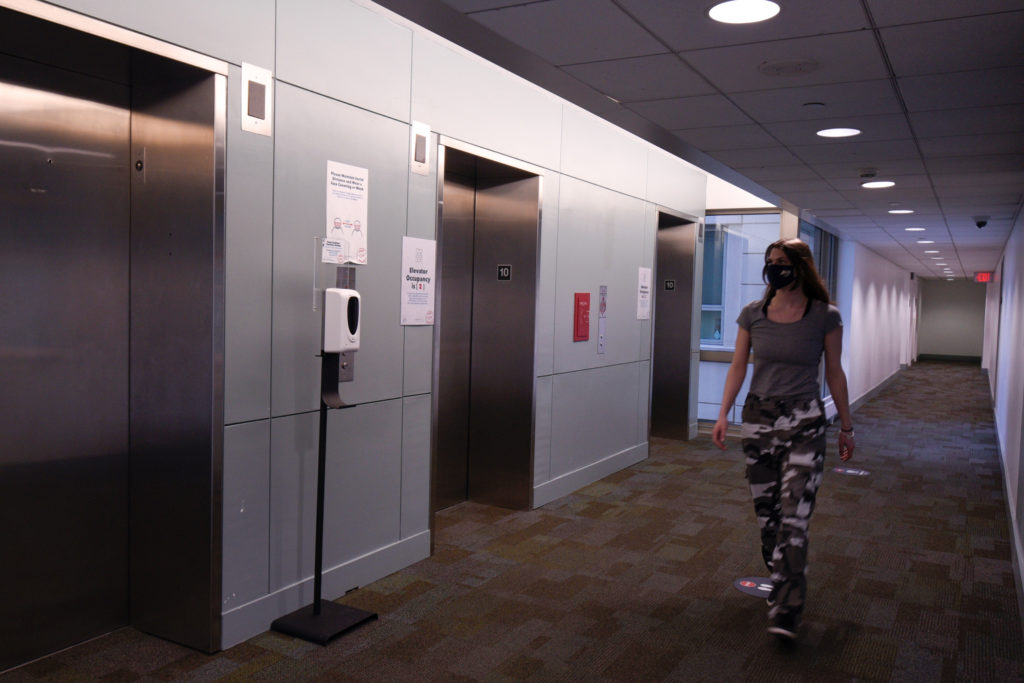The University is completing a second phase of HVAC upgrades in several campus buildings this semester to align with COVID-19 safety protocols and limit energy consumption.
David Dent, the associate vice president for facilities planning, construction and management, said officials are renovating the HVAC systems in Enterprise, Phillips, Rome, Discovery and Ames halls, Amsterdam House, the Smith Hall of Art and Building GG before June. He said officials upgraded eight other residential buildings last fall as part of the ReStart initiative, a project aimed to bolster HVAC systems on campus.
“As a result of the optimization work, these mechanical systems are performing at their maximum operational capabilities,” Dent said in an email.
Dent said District, Potomac and International houses, Shenkman, South and Aston halls, 1959 E Street and One Washington Circle received upgrades this fall. He said officials enhanced building ventilation and airflow, maximized “fan production capacity” and “outside air flow and exchanges,” repaired faulty equipment parts, renovated mechanical systems and installed MERV 13 filters – which block dust and contaminants from entering a room.
Dent said the ReStart Initiative, which is running this academic year, helped officials determine that all buildings on campus are “safe for occupancy.” The project’s first phase of upgrades in the fall cost GW $2.4 million, according to a University release issued in November.
The project also indicated that officials need to invest more into mechanical systems “to address deferred maintenance,” Dent said. He said officials identified the buildings that needed more modernization to comply with the University’s standards for carbon footprint, greenhouse gases and energy performance.
The release states that the initiative assessed the “mechanical capabilities” of each building’s HVAC system to boost safety, according to guidelines outlined by the Centers for Disease Control and Prevention; Occupational Safety and Health Administration; and American Society of Heating, Refrigerating and Air-Conditioning Engineers.
The project sets metrics for equipment, controls, environment, pollutant agility and domestic hot water, and the first phase of fall upgrades is “reaching completion” this month, according to the release.
Dent said officials are starting to draft designs for the next phase of HVAC upgrades, which will work to modernize every University building beside the Lerner Health and Wellness Center, which has already received updated designs.
Mechanical engineering experts said the University’s upgrades could enable safe ventilation during the pandemic, and officials should remain focused on maintaining frequent air filtration and finding alternative system designs to minimize energy consumption.
Leon Glicksman, a professor of building technology and mechanical engineering at the Massachusetts Institute of Technology, said effective HVAC upgrades should block aerosols that could potentially carry the coronavirus and infect people inside a building. He said upgrades should depend on air change and recycling, which determine the amount of air that enters and exits a room.
Glicksman said systems “are not necessarily designed” to frequently filter air inside a room, so officials need to upgrade the systems to increase airflow and circulation. He added that officials also need to avoid systems that create horizontal airflow, which can transport aerosols carrying potential bacteria or virus strains from one person to another.
“You don’t want to have a system which creates large horizontal flows of air because if you have a horizontal flow of air with the velocity, say one meter per second, what will happen again is if someone is ill and is giving off the virus, that virus will be carried in the airstream to other people in the room,” Glicksman said.
Glicksman said the University’s installation of the MERV 13 filter, which blocks contaminants, “works quite well” and meets the standard of ventilation expected of most buildings. He said the filters can stop all particles beside “the very tiniest” aerosols that a high-efficiency filter could block.
“People are doing what they think is best,” he said. “There has not been enough absolute standard to say this will guarantee that the building will be completely safe. It’ll certainly be safer and reduce the probability of transmission from one person to another, but that’s the state of the art right now.”
Forrest Meggers, an assistant professor of architecture at Princeton University, said the challenge for implementing HVAC upgrades under COVID-19 guidelines is the significant energy demand to ensure a maximum amount of fresh air is being delivered inside the buildings. He said the upgrades under the guidelines are often followed by a 200 to 300 percent increase in energy demand.
“We probably aren’t going to stay at that level, but it’s really exposed the sensitivity of our carbon emissions and primary energy demand to heating and cooling buildings and how the mode of heating and cooling that we do, which in the U.S. explicitly tied to air conditioning,” Meggers said.
Meggers said officials should introduce a radiant hydronic system, a heating method that utilizes running water through pipes to create heat, to address the heating and cooling components of HVAC upgrades, which he said would ultimately be more efficient.
“You’d have to think about it as a campus for HVAC systems – ‘I can make these great upgrades and make the buildings more comfortable and a little bit more efficient by putting water-based heating and cooling systems and making the ventilation be more focused on delivering care efficiently and having heat recovery,'” he said.








